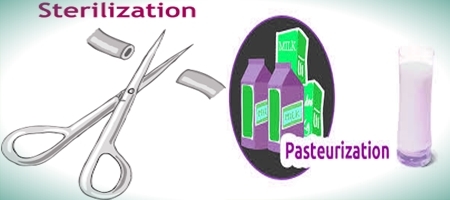Difference between Sterilization and Pasteurization

Difference between Sterilization and Pasteurization
Sterilization is described as removal of microorganisms like bacteria and fungi from food. Boiling and pasteurization are two standard methods for sterilization of food products. These methods are used to sterilize food from different microorganisms. They may kill or deactivate the organisms. Nicolas Appert was the first scientist who discovered the idea of sterilizing food items when he noticed that if heat is applied to food items, they can be preserved for long time without spoilage. The same principle was applied for sterilization of instruments used in surgical procedures because they have to enter body cavities which are sterile by nature.
Sterilization
Sterilization is any form of heat that renders any object or food items free of microorganisms. There are different kinds of methods used for sterilization. Basic classification is through heat, radiations, chemicals and filtration. Heat is further divided into steam, dry heat, flaming, incineration, tyndallization and sterilizers that are beaded with glass. Steam is used to sterilize instruments used in surgery. Dry heat is used for objects made up of steel. Flaming is used for wires. Incineration involves combustion of materials that are not reusable. Tyndallization is used for water purification and sterilization in glass beaded machinery is normally done in dental departments.
Pasteurization
It is a process which kills bacteria in any liquid diet. This concept was first given by Louis Pasteur in 1864 when he observed that heating the wine prevents it from spoilage over a considerable period of time. Pasteurization does not kill all the organisms present in the target fluid rather it only limits their number.
Sterilization Vs Pasteurization
Definition:
Sterilization is process which kills or deactivates living organism in food.
Pasteurization is the process that reduces the number of organisms in food.
Refrigeration:
Sterilized food needs not to be refrigerated.
Refrigerated food needs to be refrigerated.
Half life:
Sterilized food items have a half life of almost 15 days.
Pasteurized food items have a half life of 7 days.
Proteins:
Proteins which are sensitive to heat are not destroyed in sterilization.
Pasteurized food items have got their proteins destroyed.
Mechanism of action:
Sterilization both kills and deactivates bacteria.
Pasteurization only reduces growth and number of organisms.
Conclusion:
Pasteurization and sterilization fall under the category of modern methods of keeping the microorganisms away from food. Both are applied in different fields depending upon their advantages. But they do have some side effects like they affect the nutrition of food items.


Leave a Reply